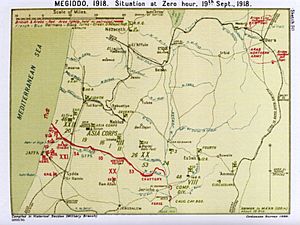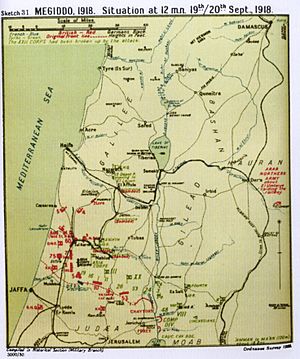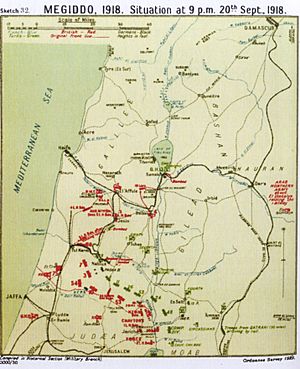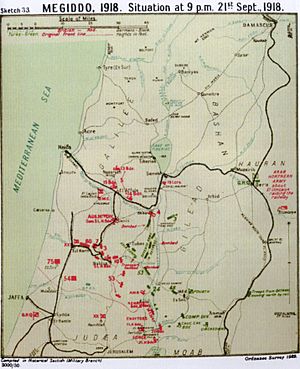Battle of Nazareth facts for kids
Quick facts for kids Battle of Nazareth |
|||||||
|---|---|---|---|---|---|---|---|
| Part of the Middle Eastern theatre of World War I | |||||||
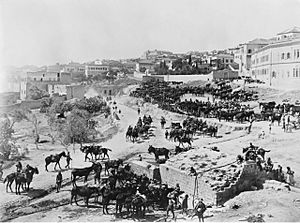 British Empire cavalry at Mary's Well, Nazareth |
|||||||
|
|||||||
| Belligerents | |||||||
| Commanders and leaders | |||||||
| Units involved | |||||||
| Egyptian Expeditionary Force Desert Mounted Corps 5th Cavalry Division 13th Cavalry Brigade |
Yildirim Army Group | ||||||
The Battle of Nazareth happened on September 20, 1918. It was part of a bigger fight called the Battle of Megiddo during World War I. This battle took place in the last months of the Sinai and Palestine Campaign. During this time, a group of soldiers on horseback, known as the Desert Mounted Corps, rode far behind the enemy lines. Their goal was to capture Nazareth, a town where the enemy's main headquarters was located.
The British Empire's infantry (foot soldiers) made it possible for the cavalry to attack Nazareth. On September 19, they broke through the Ottoman front lines. This created a gap for the cavalry to ride through. The infantry also captured important towns like Tulkarm. Meanwhile, the Desert Mounted Corps moved quickly to capture key transport hubs like Afulah and Jenin. This cut off the main escape routes for the Ottoman forces.
The 5th Cavalry Division was given the job of capturing Nazareth. This town was home to the main headquarters of the Central Powers' Yildirim Army Group. However, the path to Nazareth was difficult. The 13th Cavalry Brigade, which was supposed to lead the attack, became too small to capture the town and its headquarters. The German commander, General Otto Liman von Sanders, and his staff managed to escape during the attack. The next day, after the remaining Ottoman soldiers left, the 13th Cavalry Brigade finally took control of Nazareth.
Contents
Why the Battle Happened
After two earlier attacks in 1918, the Egyptian Expeditionary Force (EEF), led by General Edmund Allenby, controlled the Jordan Valley. Many British soldiers were sent to the Western Front in Europe. They were replaced by new soldiers from the British India Army. These new troops trained by making small attacks on the Ottoman front line. These attacks helped them get used to fighting and also moved the front line to better positions. By mid-September, the EEF was ready for a major attack.
On September 19, the British infantry successfully broke through the Ottoman lines. This allowed the Desert Mounted Corps to advance. They rode through the gap created by the infantry to surround the Ottoman armies. The cavalry captured important places like Nazareth, Haifa, Afulah, and Jenin. This cut off the Ottoman forces' escape routes. Another group of soldiers, Chaytor's Force, also captured parts of the retreating Ottoman and German armies.
How the Cavalry Was Ready
The Desert Mounted Corps was made up of several cavalry divisions. These divisions were prepared for a fast advance. They left behind extra equipment to move quickly. Each cavalry division had three brigades, and each brigade had three regiments. Most regiments had both British and Indian soldiers. Many soldiers carried rifles, bayonets, and swords. Some also had lances. They were supported by machine guns, artillery, and light armored cars.
By September 17, the 5th Cavalry Division was close to the front line. The other divisions were nearby, ready to follow. All their movements were done at night to keep them a secret. They carried enough food for themselves and their horses for a few days.
What the Cavalry Aimed For
The cavalry's main goal was to ride north, then east, to the Esdraelon Plain. This plain was also known as the Jezreel Valley or the plain of Armageddon. Their mission was to block the escape routes of the Ottoman armies. If they could capture the plain quickly, they could cut off the enemy's railway and road supplies. This plan also aimed to capture Liman von Sanders, the German commander, and his headquarters in Nazareth. The cavalry would then need to hold these captured areas.
The Esdraelon Plain
The Esdraelon Plain was very important for the Ottoman armies. It had the main roads and railways they used for supplies. The plain stretched from Lejjun in the west to Nazareth in the north. It also included Afulah in the center and Beisan in the east. This area had been a battleground for many armies throughout history.
Liman von Sanders realized the plain was not well-defended. On September 19, he ordered troops to protect the main pass leading to the plain.
Getting Ready to Fight
The plan for the Battle of Megiddo relied on surprise and speed. British artillery would fire heavily, and infantry would attack to create a gap in the enemy lines. This gap was needed for the cavalry to quickly reach the Esdraelon Plain, which was about 50 miles (80 km) behind the Ottoman front line. The Royal Air Force (RAF) and Australian Flying Corps (AFC) also played a key role. They bombed enemy headquarters to cut off communications.
The Cavalry's Advance
The Desert Mounted Corps was ordered to advance quickly, ignoring any small enemy groups. They would cross the Mount Carmel Range through two passes to reach the Esdraelon Plain. The 5th Cavalry Division would go through a northern pass to Nazareth. The 4th Cavalry Division would use a southern pass to reach Afulah. The Australian Mounted Division would follow as a reserve.
5th Cavalry Division's Journey
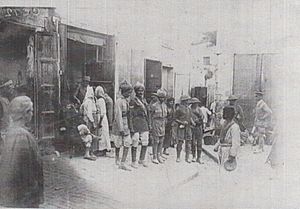
The 5th Cavalry Division began its advance. Its leading group, the 13th Cavalry Brigade, moved very fast. They captured many Ottoman soldiers and supplies along the way. At one point, they attacked an Ottoman position and took about 60 prisoners.
By 11:00 AM, the division reached Liktera, about 10 miles (16 km) north-west of Tulkarm. They had ridden 25 miles (40 km), and their horses were very tired. Some horses had to be left behind. The soldiers rested, watered their horses, and fed hundreds of prisoners. A scouting group went ahead to check the path through the Abu Shusheh Pass, reporting it was rough. Because of this, the division decided to advance without their wheeled transport at night.
The 13th and 14th Cavalry Brigades successfully rode through the Abu Shusheh Pass during the night. They reached the Esdraelon Plain and cut a section of the Haifa to Afulah railway line.
Cavalry Plans on the Plain
Once on the Esdraelon Plain, the 5th Cavalry Division's main goal was to capture Nazareth and Liman von Sanders. The 4th Cavalry Division was to capture Afulah, then move east to take Beisan. They also needed to control or destroy bridges over the Jordan River. The Australian Mounted Division was to occupy Lejjun and capture Jenin.
The Battle Begins
At dawn, British aircraft reported that cavalry brigades were entering the Esdraelon Plain. The 5th Cavalry Division sent the 14th Cavalry Brigade to Afulah. This brigade captured Afulah railway station and about 300 prisoners. The division's artillery later joined them.
The 13th Cavalry Brigade, which was heading to Nazareth, arrived at 5:30 AM. However, it was much smaller than planned due to various tasks and detachments. One group of soldiers, the 18th Lancers, mistakenly surrounded and captured 200 sleeping Ottoman soldiers in a different village. The only unit strong enough to attack Nazareth was the Gloucester Hussars.
Fighting in Nazareth
Nazareth was a town built on steep hillsides. The main roads into town joined near its southern edge. The Yildirim Army Group's offices were in the Monastery of Casa Nuova.
My Cavalry are now in rear of the Turkish Army ... One of my Cavalry Divisions surrounded Liman von Sanders' Headquarters, at Nazareth, at 03:00 today; but Liman had made a bolt, at 19:00 yesterday.
Between 5:00 and 5:30 AM on September 20, the Gloucester Hussars arrived in Nazareth. They captured many prisoners and documents. However, the main enemy records were being burned at the Monastery. The commander of the 13th Cavalry Brigade asked for help, but the 14th Cavalry Brigade could not assist. They were busy capturing Afulah.
In Nazareth, the Gloucester Hussars faced strong resistance in street fighting. German trucks blocked the narrow streets. Machine guns fired from buildings and balconies. The Gloucester Hussars were reinforced by other cavalry units. However, German office workers fought back fiercely, holding off the British attack.
By 10:55 AM, the 13th Cavalry Brigade was ordered to pull back. They had captured 1,250 prisoners. The Gloucester Hussars suffered 13 men killed. The brigade commander, Kelly, was held responsible for failing to capture Nazareth and Liman von Sanders. He lost his command.
What Happened Next
The 13th Cavalry Brigade moved to cut the road north of Nazareth. The next morning, they were ordered to return and occupy the town. By then, the German and Ottoman forces had left Nazareth. The town was occupied without any more fighting.
The 4th Cavalry Division captured Beisan, controlling the area along the Jordan River. The 5th Cavalry Division stayed in Afulah and Nazareth. The Australian Mounted Division's 3rd Light Horse Brigade occupied Jenin. This meant the Desert Mounted Corps now controlled all the main routes north. The retreating Ottoman armies were forced to use smaller roads and tracks to cross the Jordan River.
Within 36 hours, the British infantry had broken the German and Ottoman front line. The cavalry had ridden through and reached their targets. This forced the Ottoman armies to retreat north.
By the end of September 20, the British infantry had pushed the Ottoman Eighth Army out of the coastal plain. They also captured the Eighth Army headquarters. The Desert Mounted Corps blocked the main escape routes for the Ottoman armies. Many retreating soldiers were captured at Jenin.
Liman von Sanders and his staff escaped by car from Nazareth to Tiberias. From there, they drove to Samakh. Liman von Sanders organized a strong defense at Samakh, ordering his troops to fight "to the last man." During his escape, he could not communicate with his armies, leaving them without orders.
Images for kids



